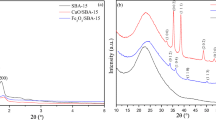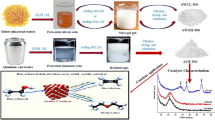Abstract
The hydrolysis of sodium borohydride (NaBH4) is a promising reaction with a possible practical application as a means of generating hydrogen. The efficiency of hydrogen production can be enhanced significantly by use of a catalyst during the reaction. Cobalt borides show significant catalytic activity, but unsupported CoB particles aggregate easily and are difficult to separate from the reaction medium for re-use. The objectives of the present study were to use halloysite (Hly) as a support material to increase the catalytic activity and reusability of a Co metal-based system and to investigate the binary effect of metal loading and reaction parameters on the hydrolysis of NaBH4. Catalysts were prepared by wet impregnation and chemical reduction. The surface morphology and structural properties of the prepared catalysts were characterized using N2 adsorption-desorption and the Brunauer-Emmet-Teller (BET) method, field emission scanning electron microscopy (FE-SEM), with energy dispersive X-ray spectroscopy (EDS), X-ray diffraction (XRD), X-ray photoelectron spectroscopy (XPS), and inductively coupled plasma mass spectrometry (ICP-MS). Response surface methodology (RSM) was used to optimize metal loading and reaction conditions for the hydrogen-generation rate. Optimum reaction conditions were determined (using Design Expert 7.0 software) as 5.01 wt.% Co loading using a Co-B/Hly-supported catalyst, 0.44 M NaBH4, 10.66 mg catalyst, and at a reaction temperature of 39.96°C. The maximum hydrogen generation rate was 33,854 mL min−1 gCo−1 under these conditions.






Similar content being viewed by others
REFERENCES
Acar, C., & Dincer, I. (2019). Review and evaluation of hydrogen production options for better environment. Journal of Cleaner Production, 218, 835–849.
Ayodele, B. V., Ghazali, A. A., Yassin, M. Y. M., & Abdullah, S. (2019). Optimization of hydrogen production by photocatalytic steam methane reforming over lanthanum modified Titanium (IV) oxide using response surface methodology. International Journal of Hydrogen Energy, 44(37), 20700–20710.
Aytar, P., Gedikli, S., Buruk, Y., Cabuk, A., & Burnak, N. (2014). Lead and nickel biosorption with a fungal biomass isolated from metal mine drainage: Box-Behnken experimental design. International Journal of Environmental Science and Technology, 11(6), 1631–1640.
Box, G. E., & Behnken, D. W. (1960). Some new three level designs for the study of quantitative variables. Technometrics, 2(4), 455–475.
Chen, D., Liu, C., Mao, Y., Wang, W., & Li, T. (2020). Efficient hydrogen production from ethanol steam reforming over layer-controlled graphene-encapsulated Ni catalysts. Journal of Cleaner Production, 252, 119907.
Dai, H. B., Kang, X. D., & Wang, P. (2010). Ruthenium nanoparticles immobilized in montmorillonite used as catalyst for methanolysis of ammonia borane. International Journal of Hydrogen Energy, 35(19), 10317–10323.
Daza-Gomez, L. C., Ruiz-Ruiz, V. F., Mendoza-Nieto, J. A., Pfeiffer, H., & Diaz, D. (2020). Co3O4 nanostructures and Co3O4 supported on halloysite nanotubes: New highly active and thermally stable feasible catalysts for CO oxidation. Applied Clay Science, 190, 105590.
Derringer, G., & Suich, R. (1980). Simultaneous optimization of several response variables. Journal of Quality Technology, 12, 214–219.
Elliott, E. P., Barrett, E. P., Joyner, L. G., & Halenda, P. P. (1951). The determination of pore volume and area distributions in porous substances. I. Computations from nitrogen isotherms. Journal of the American Chemical Society, 73(1), 373–380.
Erol, S., & Özdemir, M. (2017). Development of Co-B/Magnesite catalyst for hydrogen generation by Hydrolysis of sodium borohydride. Journal of The Turkish Chemical Society: Section B Engineering, 1, 69–76.
Fernandes, R., Patel, N., Miotello, A., & Filippi, M. (2009). Studies on catalytic behavior of Co-Ni-B in hydrogen production by hydrolysis of NaBH4. Journal of Molecular Catalysis A: Chemical, 298, 1–6.
Guo, W. Q., Ren, N. Q., Wang, X. J., Xiang, W. S., Ding, J., You, Y., & Liu, B. F. (2009). Optimization of culture conditions for hydrogen production by EthanoligenensharbinenseB49 using response surface methodology. Bioresource Technology, 100(3), 1192–1196.
Guo, J., Hou, Y., Li, B., & Liu, Y. (2018). Novel Ni-Co-B hollow nanospheres promote hydrogen generation from the hydrolysis of sodium borohydride. International Journal of Hydrogen Energy, 43, 15245–15254.
Hitit, Z. Y., Lazaro, C. Z., & Hallenbeck, P. C. (2017). Hydrogen production by co-cultures of Clostridium butyricum and Rhodospeudomonas palustris: Optimization of yield using response surface methodology. International Journal of Hydrogen Energy, 42(10), 6578–6589.
Hosgun, H. L., Ture, A. G., Hosgun, E. Z., & Bozan, B. (2020). Synthesis 5-hydroxymethylfurfural (5-HMF) from fructose over cetyl trimethylammonium bromide-directed mesoporous alumina catalyst: effect of cetyl trimethylammonium bromide amount and calcination temperature. Reaction Kinetics, Mechanisms and Catalysis, 129, 337–347.
Ingersoll, J. C., Mani, N., Thenmozhiyal, J. C., & Muthaiah, A. (2007). Catalytic hydrolysis of sodium borohydride by a novel nickel–cobalt–boride catalyst. Journal of Power Sources, 173(1), 450–457.
Jeong, S. U., Cho, E. A., Nam, S. W., Oh, I. H., Jung, U. H., & Kim, S. H. (2007). Effect of preparation method on Co-B catalytic activity for hydrogen generation from alkali NaBH4 solution. International Journal of Hydrogen Energy, 32, 1749–1754.
Jitrwung, R., & Yargeau, V. (2011). Optimization of media composition for the production of biohydrogen from waste glycerol. International Journal of Hydrogen Energy, 36(16), 9602–9611.
Kaze, C. R., Alomayri, T., Hasan, A., Tome, S., Lecomte-Nana, G. L., Nemaleu, J. G. D., Tchakoute, H. K., Kamseu, E., Melo, U. C., & Rhaier, H. (2020). Reaction kinetics and rhelogical behaviour of meta-halloysite based geopolymer cured at room temperature: Effect of thermal activation on physiochemical and microstructural properties. Applied Clay Science, 196, 105773.
Kim, C., Lee, S. S., Li, W., & Fortner, J. D. (2020). Towards optimizing cobalt based metal oxide nanocrystals for hydrogen generation via NaBH4 hydrolysis. Applied Catalysis A: General, 589, 117303.
Krasilin, A. A. (2020). Energy modeling of competition between tubular and platy morphologies of chrysotile and halloysite layers. Clays and Clay Minerals, 68, 436–445.
Krishnan, P., Advani, S. G., & Prasad, A. K. (2008). Cobalt oxides as Co2B catalyst precursors for the hydrolysis of sodium borohydride solutions to generate hydrogen for PEM fuel cells. International Journal of Hydrogen Energy, 33(23), 7095–7102.
Li, X., Fan, G., & Zeng, C. (2014). Synthesis of ruthenium nanoparticles deposited on graphene-like transition metal carbide as an effective catalyst for the hydrolysis of sodium borohydride. International Journal of Hydrogen Energy, 39(27), 14927–14934.
Li, Z., Wang, L., Zhang, Y., & Xie, G. (2017). Properties of Cu-Co-P/γ-Al2O3 catalysts for efficient hydrogen generation by hydrolysis of alkaline NaBH4 solution. International Journal of Hydrogen Energy, 42, 5749–5757.
Lim, S., Park, S., & Sohn, D. (2020). Modification of halloysite nanotubes for enhancement of gas-adsorption capacity. Clays and Clay Minerals, 68, 189–196.
Liu, B. H., Li, Z. P., & Suda, S. (2006). Nickel- and cobalt-based catalysts for hydrogen generation by hydrolysis of borohydride. Journal of Alloys and Compounds, 415, 288–293.
Lu, A., Chen, Y., Jin, J., Yue, G. H., & Peng, D. L. (2012). CoO nanocrystals as a highly active catalyst for the generation of hydrogen from hydrolysis of sodium borohydride. Journal of Power Sources, 220, 391–398.
Manna, J., Ror, B., Vasthistha, M., & Sharma, P. (2014). Effect of Co+2/BH4- ratio in the synthesis of Co-B catalysys on sodium borohydride hydrolysis. International Journal of Hydrogen Energy, 39, 406–413.
Mishra, P., Ameen, F., Zaid, R. M., Singh, L., Ab Wahid, Z., Islam, M. A., & Al Nadhari, S. (2019). Relative effectiveness of substrate-inoculum ratio and initial pH on hydrogen production from palm oil mill effluent: Kinetics and statistical optimization. Journal of Cleaner Production, 228, 276–283.
Montgomery, D. C. (2017). Design and analysis of experiments. John Wiley and Sons.
Myers, R.H., Montgomery, D.C., & Anderson-Cook, C.M. (2016). Response Surface Methodology: Process and Product Optimization using Designed Experiments. John Wiley & Sons, Hoboken, New Jersey, USA.
Ozkan, G., Akkus, M. S., & Ozkan, G. (2019). The effects of operating conditions on hydrogen production from sodium borohydride using Box-Wilson optimization technique. International Journal of Hydrogen Energy, 44(20), 9811–9816.
Patel, N., & Mitello, A. (2015). Progress in Co–B related catalyst for hydrogen production by hydrolysis of boron-hydrides: A review and the perspectives to substitute noble metals. International Journal of Hydrogen Energy, 40(3), 1429–1464.
San, F. G. B., Karadag, C. I., Okur, O., & Okumus, E. (2016). Optimization of the catalyst loading for the direct borohydride fuel cell. Energy, 114, 214–224.
Sarac, N., Uğur, A., Simsek, Ö., Aytar, P., Toptas, Y., Buruk, Y., Cabuk, A., & Burnak, N. (2017). Phenol Tolerance and Biodegradation Optimization of Serratia Marcescens NS09-1 Using Plackett-Burman and Box-Behnken Design. Environmental Engineering and Management Journal, 16(11), 2637–2645.
Sahin, Ö., Kılınc, D., & Saka, C. (2016). Bimetallic Co-Ni based complex catalyst for hydrogen production by catalytic hydrolysis of sodium borohydride with an alternative approach. Journal of Energy Institute, 89, 617–626.
Sahiner, N., & Sengel, S. (2017). Environmentally benign halloysite clay nanotubes as alternative catalyst to metal nanoparticles in H2 production from methanolysis of sodium borohydride. Fuel Processing Technology, 158, 1–8.
Sahiner, N., & Sengel, S. (2017). Various amine functionalized halloysite nanotube as efficient metal free catalyst for H2 generation from sodium borohydride methanolysis. Applied Clay Science, 146, 517–525.
Tian, H., Guo, Q., & Xu, D. (2010). Hydrogen generation from catalytic hydrolysis of alkaline sodium borohydride solution using attapulgite clay-supported Co-B catalyst. Journal of Power Sources, 195, 2136–2142.
Vinokurov, V., Sitavitskaya, A., Gulatov, A., Ostudin, A., Sosna, M., Gushchin, P., Darrat, Y., & Lvov, Y. (2018). Halloysite nanotube-based cobalt mesocatalysts for hydrogen production from sodium borohydride. Journal of Solid State Chemistry, 268, 182–189.
Wang, J., & Wan, W. (2009). Application of desirability function based on neural network for optimizing bio hydrogen production process. International Journal of Hydrogen Energy, 34(3), 1253–1259.
Wang, Y., Li, T., Bai, S., Qi, K., Cao, Z., Zhang, K., Wu, S., & Wang, D. (2016). Catalytic hydrolysis of sodium borohydride via nanostructured cobalt–boron catalysts. International Journal of Hydrogen Energy, 41(1), 276–284.
Wang, L., Li, Z., Zhang, Y., Zhang, T., & Xie, G. (2017). Hydrogen generation from alkaline NaBH4 solution using electroless-deposited Co-Ni-W-P/γ-Al2O3 as catalysts. Journal of Alloys and Compounds, 702, 649–658.
Watts, C. F., & Wolstenholme, J. (2003). An Introduction to Surface Analysis by XPS and AES. Wiley-Blackwell, Oxford, UK.
Wu, C., Bai, Y., Liu, D. X., Wu, F., Pang, M. L., & Yi, B. L. (2011) Ni–Co–B catalyst-promoted hydrogen generation by hydrolyzing NaBH4 solution for in situ hydrogen supply of portable fuel cells. Catalysis Today, 170(1), 33–39.
Wu, C., Wu, F., Bai, Y., Yi, B., & Zhang, H. (2005). Cobalt boride catalysts for hydrogen generation from alkaline NaBH4 solution. Materials Letter, 33, 7385–7391.
Xu, D., Zhang, H., & Ye, W. (2007). Hydrogen generation from hydrolysis of alkaline sodium borohydride solution using Pt/C catalyst. Catalysis Communications, 8(11), 1767–1771.
Xu, D., Dai, P., Liu, X., Cao, C., & Guo, Q. (2008). Carbon-supported cobalt catalyst for hydrogen generation from alkaline sodium borohydride solution. Journal of Power Sources, 182(2), 616–620.
Xu, D., Wang, H., Guo, Q., & Ji, S. (2011). Catalytic behavior of carbon supported Ni-Bi Co-B and Co-Ni-B in hydrogen generation by hydrolysis of KBH4. Fuel Processing Technology, 92, 1606–1610.
Yang, C. C., Chen, M. S., & Chen, Y. W. (2011). Hydrogen generation by hydrolysis of sodium borohydride on CoB/SiO2 catalyst. International Journal of Hydrogen Energy, 36(2), 1418–1423.
Yin, Y., & Wang, J. (2019). Optimization of fermentative hydrogen production by Enterococcus faecium INET2 using response surface methodology. International Journal of Hydrogen Energy, 44(3), 1483–1491.
Zhang, H., Ling, T., & Du, X. W. (2015). Gas-Phase cation exchange toward porous single-crystal CoO nanorods for catalytic hydrogen production. Chemistry of Materials, 27(1), 352–357.
Zhang, H., Feng, X., Cheng, L., Hou, X., Li, Y., & Han, S. (2019). Non-noble Co-anchored on nanoporous graphene oxide, as an efficient and long-life catalyst for hydrogen generation from sodium borohydride. Colids and Surfaces A: Physicochemical and Engineering Aspect, 563, 112–119.
Author information
Authors and Affiliations
Corresponding author
Ethics declarations
Conflict of Interest
The authors declare that they have no conflict of interest.
Additional information
(Received 26 September 2020; revised 26 January 2021; AE: Hongping He)
Rights and permissions
About this article
Cite this article
Hosgun, S., Ozdemir, M. & Sahin, Y.B. OPTIMIZATION OF HYDROGEN GENERATION BY CATALYTIC HYDROLYSIS OF NaBH4 WITH HALLOYSITE-SUPPORTED CoB CATALYST USING RESPONSE SURFACE METHODOLOGY. Clays Clay Miner. 69, 128–141 (2021). https://doi.org/10.1007/s42860-021-00113-0
Accepted:
Published:
Issue Date:
DOI: https://doi.org/10.1007/s42860-021-00113-0




